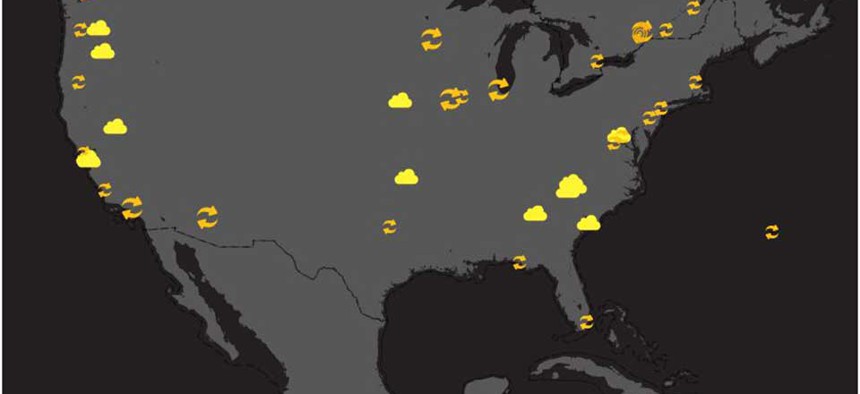
Matti Schneider via The Atlantic Cities
Here's a List of Data Centers the NSA Is (Probably) Spying On
The sheer amount of Internet concentrated in these facilities makes them hot targets for spy agencies like the NSA. By John Metcalfe
The U.S. government may have shut down, but you know its vast spying apparatus is working hard. And what might it be doing right now? Penetrating private Facebook accounts? Slipping Trojan horses into computers at The Guardian ?
Ordinary citizens might never know what their government is up to security-wise, but it is possible to guess where it's conducting nefarious snooping activities. That's because when spooks eavesdrop on web communications, they're targeting Internet infrastructure with a very physical presence. It might be Internet exchange points through which floods of information pass among networks, for instance, or sprawling "server farms" that allow cloud computing to exist. Google operates one of the latter in the city of Lenoir, North Carolina, and the amount of data-handling equipment it contains is stunning. Here's the outside, reminiscent of a slab of the Great Wall of China:
The cavernous inside is guarded by at least one stormtrooper:
(via Google Maps)
The sheer amount of Internet concentrated in these facilities, to put it dumbly, makes them hot targets for spy agencies like the NSA and GCHQ. At least so asserts Matti Schneider, a French software engineer who recently debuted an intriguing map of " State Surveillance Baits ." Schneider says he made the cryptologic-flavored cartography for this September's EU Hackathon to address the question, “What does government surveillance look like around the world?” He writes:
State surveillance is an activity in which governments don’t often take pride nowadays. As such, and as Snowden proved by contrast with the months preceding his revelations, its full extent is impossible to measure.
Based on that consideration, instead of trying to visualize surveillance itself, an endless pursuit, the best way to get a grasp of its extent is probably to visualize its possible targets.
Schneider's motto for the project is "If we can't find the beast, better find its preys." And here they are: Big, juicy data nodes whose locations he gleaned from company press releases and a helpful engineer at Facebook. The cloud-shaped icons are server farms; the rotating arrows are exchange points (the larger ones are more substantial installations); and the whirlpools represent countries that issue biometric passports with features like fingerprints and iris scans. That passport info "allows tracking through CCTV or any other automated detection means," Schneider says:
Here's a zoom on the U.S. and the Caribbean:
Schneider's interactive visualization sheds bright light on the geography of these sites, but does little to show what they actually look like in person. To give a couple examples of that, let's first fly above the Arizona Internet Exchange in Phoenix. Dubbed AZIX for short, the recently opened facility dominates the land. Just look how relatively tiny its on-site parking lots are:
This is the Equinix data center on Eighth Avenue at 15th Street in New York City (it's in the block-sized building):
Behold the mighty Midwest Internet Cooperative Exchange in downtown Minneapolis, cutely known as MICE:
Below is one of the most bulky data centers in the New York metro area. The 338,967-square-foot Equinix behemoth, marked by a rust-colored Tetris L on its roof, blends in with other massively blah buildings in Secaucus, New Jersey. The structure at top left is yet another Equinix data center:
And here's one all-seeing eye that is resisting outside scrutiny, the U.S. intelligence community's new $1.5 billion Utah Data Center, led by the NSA and possibly now open for business :
Map created by Matti Schneider ; photos from Google Maps; Utah Data Center image from Swilsonmc on Wikipedia








